Save money while you avoid the synthetic fragrances and other additives in commercial laundry detergents by learning how to make a DIY laundry detergent at home.
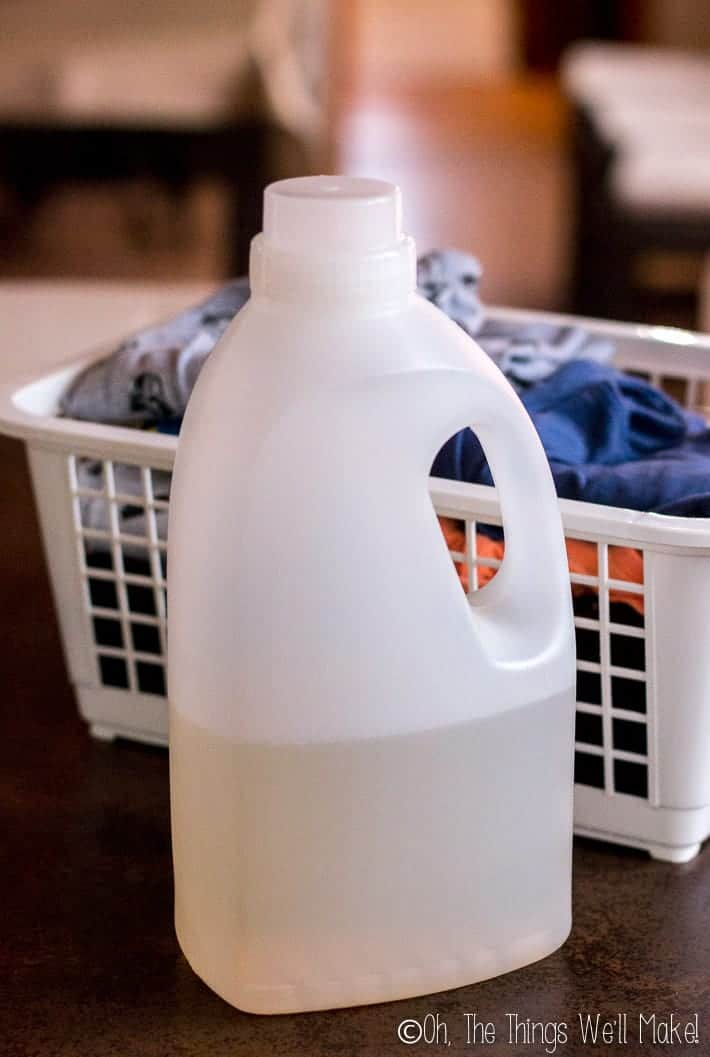
Over a year ago, I showed you how to make a homemade laundry “detergent” using soap. It was actually a guest post written by someone who works in a cleaning company. It is very simple to make and uses very natural ingredients like soap flakes and baking soda. Heck, I even showed you how to make a laundry soap with coconut oil, a super easy soap that is perfect for that sort of recipe (and for beginner soap makers!). I made and used her “detergent” recipe quite successfully for many months before I started dabbling in the world of working with surfactants.
The problem with soap-based laundry detergents
While my original recipe worked well for me for quite some time, it’s not the most ideal solution for cleaning your clothes, especially for those who have hard water. Soap is susceptible to forming what is known as soap scum. It’s a bit of a buildup that forms when the soap is added to hard water. Hard water has calcium and magnesium ions that react with the sodium salts in the soap. The reaction results in calcium and magnesium salts which are precipitated as soap scum.
Why is soap scum a problem?
Soap scum is a problem because it can build up on your clothes and can bind with it other undesirable substances like oils and dirt, but also possibly bacteria and/or other microbes.
Many people successfully use soap-based laundry detergents without noticing any problems. Others, though, notice that their clothes appear dingy after repeated use. Perhaps I was able to avoid the unpleasantness due to the fact that we have a water softener at home. We live in an area of Spain with very hard water, and most of the family was feeling itchy after showering. Plus, I constantly felt a buildup in my hair, even when I experimented with washing my hair with only water for a while. So, we finally installed a water softening system.
With softer water, soap scum isn’t as big of a problem because you won’t have as many calcium and magnesium salts precipitating out. Detergents also can save you from soap scum buildup.
“Stripping” your clothes
After repeated washings with soap, many people have decided to do what’s called “stripping,” basically a deep, thorough cleansing of the clothes with substances that help remove the mineral buildup in their clothes. You can read more about the problem with using soap-based laundry detergents, and about stripping your clothes here.
I actually tried doing it with a DIY mix of borax, washing soda, and Calgon, and while I did end up with somewhat yucky looking water, it didn’t look that much different than the water obtained from “stripping” my newer clothes that had only been washed in detergent based cleansers. That, again, could also be due to the fact that I have soft water so my clothes probably didn’t have as much of a soap scum buildup on them.
Why make your own Laundry detergent?
So, you’ve decided not to use a soap-based laundry detergent, but what should you use instead? Working with surfactants can sound a bit daunting, right? It just doesn’t feel as “natural” to use detergents or other surfactants that aren’t soap. (If you are interested in reading more about natural surfactants, I’d recommend checking out my beginner’s guide to working with natural surfactants.)
Once you get over the initial fear of working with new products, though, you’ll realize that it’s still a really great idea to make your own laundry detergent.
Making your own laundry detergent saves money!
Let’s start with one of the biggest advantages of making your own detergent: it’s a great way to save money!
Most “natural” laundry detergents are expensive. Heck, even the not-so-natural ones tend to be overpriced when you think about their composition. They are mostly water mixed with some surfactants and many of those surfactants are actually quite inexpensive!
This, of course, depends on where you are buying them and in what quantities. I bought 5 liters of SLS here in Spain for just over 20 Euros. That’s enough for me to make many bottles of detergent!
When you make your own laundry detergent, you have more control over the ingredients.
One of the main reasons I like to make my own detergent is that I try to avoid synthetic fragrances in most store-bought detergents, some of which are very strongly scented. I’m actually quite sensitive to many of those fragrances and find myself nauseous when I’m in the same room with somebody who uses strongly scented detergents and fabric softeners.
When making my own laundry detergent, I use essential oils to scent it, or, more often, I keep the detergent unscented. I find it more effective to add a few drops of lavender essential oil to my homemade wool dryer balls and throw them in the clothes dryer when drying my clothes. Doing that leaves my clothes with a more natural, less overbearing fragrance. (I have since been informed that there is a risk, albeit small, of EO’s igniting in the dryer when used in dryer balls. When used in such small amounts, it’s highly unlikely, but do so at your own risk! It may be better to scent your clothes with homemade lavender sachets in your closet instead!)
Making your own detergent also allows you to avoid any ingredients that are problematic for you!
Isn’t sodium lauryl sulfate bad/unnatural/to be avoided?
OK, I know what you’re thinking…
So, I’m talking about controlling the ingredients and using more natural ingredients, and then I go and use one of the most hated surfactants of all time, right?!?!?
Sodium lauryl sulfate, aka. SLS, is a detergent type surfactant that does a wonderful job of cutting grease. It makes lots of suds and it is very inexpensive. It’s also derived from coconut oil and is completely biodegradable, something that most green-minded people should appreciate.
But isn’t SLS bad and cancer causing?
Well, not really.
I haven’t found any studies that show SLS causes cancer and many of the sites that bash SLS repeat a lot of the same information that either doesn’t have a real scientific basis, or that does, but whose results have been interpreted wrong. One example is the claim that SLS can react with formaldehyde to produce “nitrosating agents.” But as neither have nitrogen atoms, that would be impossible. (You can read more about SLS myths and studies here.)
While it does find its origins in coconut oil, it also needs quite a bit of synthesizing to make it, so it’s not really a very “natural” product. That is enough to make some people want to avoid it, but sometimes “natural” isn’t always best. (I would choose a lab-made iron oxide colorant over a completely natural one for homemade cosmetics as the naturally foudn ones are usually contaminated with heavy metals.) What we are looking for is making products that are safe. While I prefer natural products, safety trumps natural for me any day!
SLS does have other disadvantages. It is a rather harsh surfactant, when compared to some of the others, that can irritate sensitive skin. It finds its way into a lot of personal care products where I don’t really think it should be used (like toothpaste, for example, which is why you may consider making your own toothpaste instead). I personally don’t and wouldn’t use SLS in my homemade body care products like homemade shampoos.
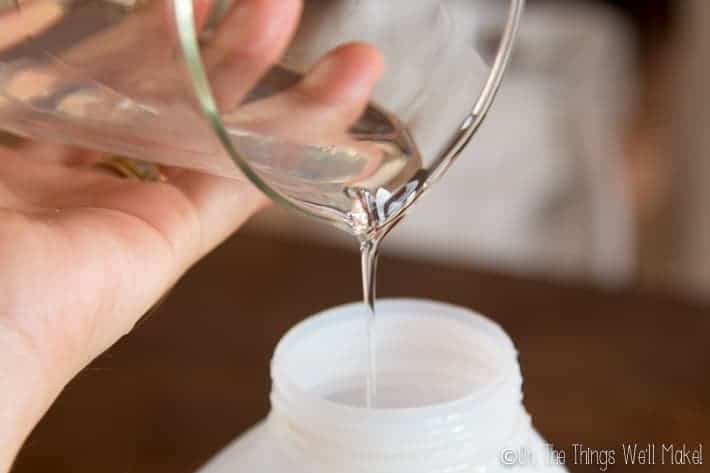
Why use SLS?
That said, laundry detergent isn’t a personal care type product. The superior cleansing ability of SLS really works to our advantage when we are trying to clean our clothes of dirt and grime. For me, it’s worth using here. I’ve combined it with gentler, more natural surfactants to help balance things out.
SLS isn’t essential in a detergent, of course, but it will make for a better cleaning detergent. I think even most “natural” detergents I’ve seen probably are using it without completely disclosing as they are afraid of the stigma associated with using it. (I often see the detergents with ingredients listed as “non-ionic surfactants,” the most famous of which, of course, is SLS.) You can read more about the categories of surfactants in my post about natural surfactants.
Dr. Bronner’s Sal Suds is another product that unapologetically uses SLS in it. In fact, their formula was my inspiration for this laundry detergent. (I also use this mixture for all sorts of general cleaning around the house!) They also touched on why they feel it’s safe to use for general cleaning in the post on their website.
Customizing your homemade laundry detergent
As I mentioned earlier, you could experiment a bit with varying the different surfactants in this detergent recipe. This recipe, however, is thickened with salt, and not all surfactant combinations will thicken in the same way (or at all) when using salt.
Why add salt?
Certain surfactant mixes can easily be thickened by adding salt to them and it’s a wonderful way to thicken them because you don’t need to deal with gums or other thickeners. This recipe is one example where salt works perfectly for thickening up the detergent. Without it, the detergent will still be concentrated and potent, but it won’t really look that way. You’d end up with a very liquidy product. Most people equate thick, viscous soaps and detergents as being more concentrated, even when that isn’t always the case.
The salt in this recipe is around 2% of the recipe and I’ve found that it makes for a nice thickness. You may be able to thicken it even more with slightly more salt, but you have to be careful when experimenting with the amount of added salt. The thickening properties of the salt follow what is called a “salt curve.” The product will continue to thicken up until a certain point. After that, adding more salt will only thin out the product again!
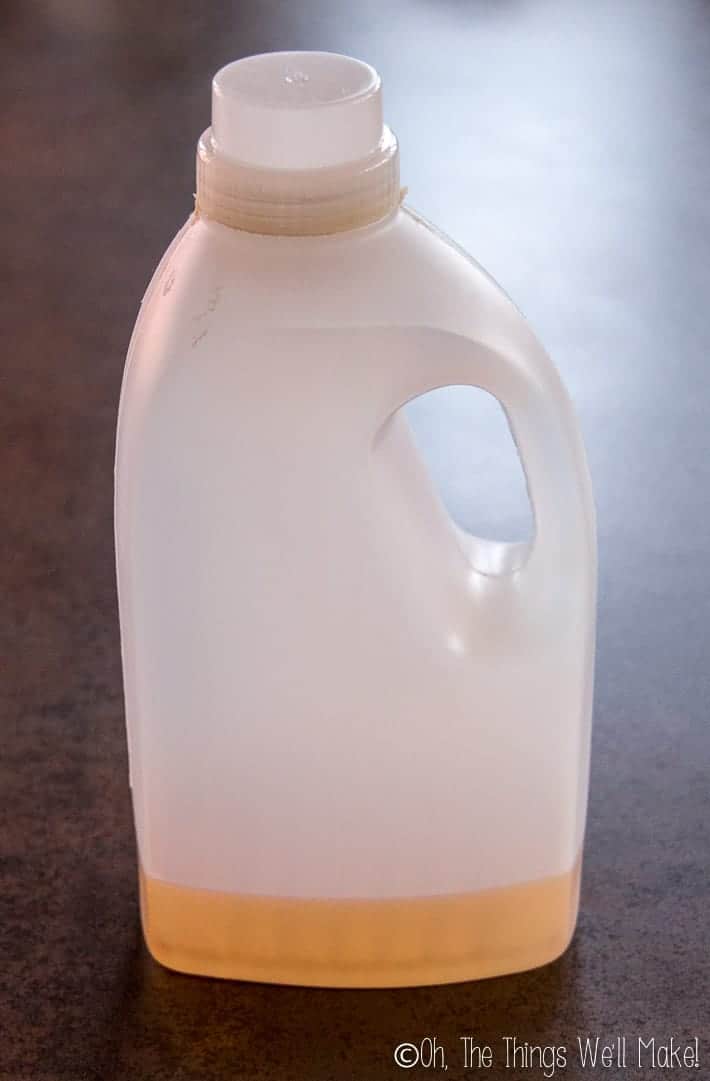
Customizing the surfactants
I very much like this combination of surfactants, and have found it to make a nice looking product that is very effective. I’ve used around 15% SLS, 5% coco betaine, and 3% decyl glucoside. (You can read more about the last two surfactants here.)
If you are determined to make an SLS-free detergent, you’ll have to do some experimentation. You’ll likely want to use a higher total concentration of surfactants, too, as the more gentle, natural surfactants aren’t as effective at cleaning. My recipe uses around 23% surfactants, but when using gentler surfactants, you’ll want to find combinations of surfactants that complement each other, and will likely want to use somewhere around 30-40% or even more.
Another thing to keep in mind is that not all surfactant mixtures can be thickened with salt. When using other combinations, you may need to add a gum like xanthan gum to thicken your final product. (Or just use a more liquid product, knowing that the thickness isn’t what is making your detergent stronger and more concentrated.)
Adding essential oils or fragrances
I didn’t add any essential oils or fragrances to this recipe because I prefer to add a couple of drops of lavender essential oil to my homemade wool dryer balls when drying my clothes. I find it to be a more effective way of scenting them. (I have since been informed that there is a risk, albeit small, of EO’s igniting in the dryer when used in dryer balls. When used in such small amounts, it’s highly unlikely, but do so at your own risk! It may be better to scent your clothes with homemade lavender sachets in your closet instead!)
That said, you can use essential oils or fragrance oils to scent your homemade detergent (or you can just add a few drops of essential oils to your rinse water). I’d suggest using small amounts of EO’s because larger quantities may not be fully solubilized into the mixture, and you may end up with some separation. (These surfactants do have a certain amount of solubilizing ability, but that is limited without adding some sort of solubilizer.)
Do you need a preservative?
YES!
Any homemade product with water in it will need some sort of preservative to keep bacteria and mold away. The surfactants on their own are either self-preserved (by extreme pH’s) or have preservatives added to them to keep them free from microbial growth. Once you start adding more water to them, though, you’ll need to find a way to keep the microbes away.
Using pH as a “preservative”
There are certain ways to go about it. Dr. Bronner’s Sal Suds have the following ingredients: Water, Sodium Lauryl Sulfate (SLS), Coco-Betaine, Decyl Glucoside, Abies Siberica (Siberian Fir) Needle Oil, Picea Glauca (Spruce) Leaf Oil, Citric Acid, Sodium Sulfate, Sodium Chloride, Potassium Hydroxide
Their recipe differs from mine in the use of sodium sulfate (normally used as a filler in powdered laundry detergents) and potassium hydroxide. I’m not quite sure why they chose to use sodium sulfate in a liquid detergent type product.
Potassium hydroxide is a strong base that I use when making liquid soap. I could be wrong here, but my suspicion is that they chose to add it to alkalinize the mixture which makes it inhospitable to microbes. If you can make a product with a pH higher than 9 or lower than 4, you don’t generally need a preservative. (Sal Suds have a pH of around 9-9.5 according to a friend of mine who tested with pH test strips.) This, of course, depends on what sorts of ingredients you are using. Organic type ingredients like milks, plant material, and clays are more difficult to preserve. Normally, though, it should keep your product safe for up to a year. This is also the main reason that you don’t need a preservative with liquid soaps.
Most preservatives don’t work very well at high extremes anyway. Without adding KOH to this recipe, my detergent falls has a pH of around 5.
I haven’t tried adding KOH to this mixture yet, but probably will the next time I have to mix some up. It is likely the most cost effective solution to preserving a detergent like this one, especially if you already like to make your own liquid soaps, so it’s really a great way to preserve the product. I’ll let you know my findings when I get around to it.
Using natural preservatives
There are a number of natural preservatives that you can use to preserve this product instead. I’ve been using one called Sharomix 705. It’s an Ecocert safe preservative that seems to be doing a pretty good job in my formula. (Sharomix can be used in products with a pH under 5.5, and should be used at a concentration of 0.6-1.2% of the recipe.) I had bought it inexpensively in large quantities, so I had plenty at home to use up and experiment with.
The important thing to keep in mind here is that you’ll want to make sure the pH of the detergent is adequate for the preservative you are using. Most suppliers will share the effective pH range for their particular preservative. They’ll also let you know an effective percentage to use.
In my recipe below, I’ve used the preservative at 1% of the recipe. That’s a general range that is the amount needed for many of the more popular natural preservatives. Some of them may need to be used in higher quantities, in which case you could reduce the water content to make up for the addition of more preservative.
I’ve been doing more research on a number of natural preservatives and hope to get a post about them to you soon!
Meanwhile…
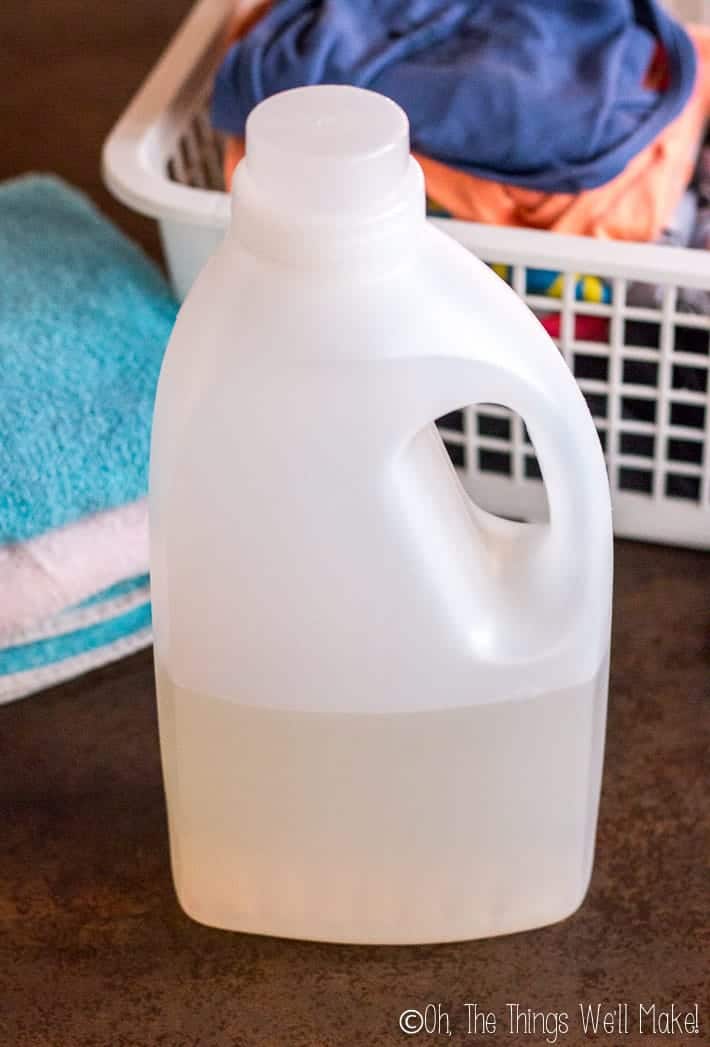
Surfactant-based homemade liquid laundry detergent
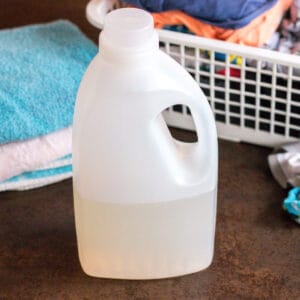
DIY Liquid Laundry Detergent (Non-Soap)
Materials
- 740 g distilled water
- 150 g sodium lauryl sulfate
- 50 g coco betaine
- 30 g decyl glucoside
- 20 g salt
- 10 g preservative
Instructions
- Begin by adding the surfactants to your container. I cleaned out an old laundry detergent bottle from a natural laundry detergent that I had bought in the local eco-supermarket. The easiest way to add them is to tare the scale with your container on top to set the scale to zero. You can then add one of the surfactants before taring the scale again. Taring the scale between adding each ingredient is the easiest way to weigh out your ingredients.
- Once you've added the surfactants, add the distilled water. You can now gently stir or agitate the bottle to mix the surfactants with the water. Mix them gently so as not to form too much foam.
- You can now add the salt into your mixture, again gently stirring to incorporate it. The mixture will thicken up as the salt dissolves into the mixture. (You can also choose to separate out a small portion of the water and dissolve the salt in that water before adding it to the detergent mixture. This may help more efficiently combining all ingredients more easily.)
- Finally, add your preservative. I like to switch to a smaller, more precise scale for weighing out my preservative and other ingredients used in smaller quantities. (This scale is a good example.)
- You are now ready to use your homemade detergent just as you would a store bought one. (I'd suggest using around 2-3 Tbsp. per load.)
To help boost cleasning, you could consider adding some baking soda to your wash water too and/or use vinegar in your final rinse as a natural fabric softener.
Now that you’ve made your own laundry detergent, why not make your own natural fabric softener and wool dryer balls too?
 Español
Español


 Vegan Glycerin Soap
Vegan Glycerin Soap
Lea E
Is there anything that I can sub for the SLS?
Tracy Ariza, DDS
I’d suggest using another anionic surfactant so that you have good cleansing properties. Some won’t thicken with salt, though, so keep that in mind. For a thick detergent that is easy to dose properly, you may need to thicken it with a gum like xanthan gum.
Becca
Hi Tracy,
I was wondering if you could update the recipe, or comment back to me, about how much KOH to use to adjust the ph in order to not have to use the preservative? At what point would the KOH be added?
Thank you! I love your recipes!! They are what first gave me confidence to start soap making, and now I am experimenting with my own surfactant combinations (after much research).
Tracy Ariza, DDS
Sorry for the late reply. I need to make a new batch soon, and was waiting to see. It’s definitely on my to-do list. One time, I calculated it and then lost the paper with the measurements. Sigh. The next time, I added a bit too much and the pH was quite high…
Perhaps the 3rd time is the charm? 😉
Glau
Hi, Tracy!
Thank you for all the recipes in this website. Amazing job! I’ve been trying a few and this one is definitely in my list to try. Could we use this laundry detergent as dish soap/detergent too? I don’t use my dishwasher. I hand wash all my dishes. I use my dishwasher as storage for pots and lids lol
Thanks in advance and Happy New Year!
Tracy Ariza, DDS
Hi Glau,
Yes! I0ve used this for washing dishes before. I tried it in the dishwasher too, but I have to say that it left a bot of a film on the glasses, so I don’t recommend it for the dishwasher. For hand washing, though, it works well. I also hand wash with my homemade liquid soaps.
I did come up with a solution for the dishwasher, but I lost my recipe. I was considering trying to recreate it again today as I ran out. It’s definitely on my to-do list, though, for posting a recipe for the blog. 😉
Monica
If you wish something to wash your dishes I am able to give you a very good solution which for me works amazingly.
Everything started from an all purpose cleaner .
It has the following ingredients:
-1 Tbs baking soda
-2Tbs vinegar
-375 mils. of warm water
-2Tbs. dishwasher soap
-essential oil at your choice (lemon, peppermint, clove, rosemary)
Mix baking soda with vinegar and let it fizzle.
Mix the 2Tbs of dish soap with ess. Oil of your choice as many drops as you like in a separate small dish.
Than add the water to bic. Of soda and vinegar, followed by mixture of dish soap and ess. Oil. Mix well.
Unfortunately I was not happy to use it as all purpose cleaner because of bicarbonate of soda letting behind white spots after drying.
I realised it needs rinse with clean water to wipe away the spots.
Not wanting to loose the solution I mixed 2 parts of that all purpose cleaner with 1 part more dish soap.
To my surprise I made a mix which cleans my dishes wonderfully.
Try it and you might be happy with the result.
Adrienne
Hi there – what dishwasher soap are you using…just a store bought one?
Rebeca
Hola tracy! Muchisimas gracias por esta maravillosa receta.
Una pregunta, ¿se podria cambiar la betaina de coco por tegobetaina?
Muchísimas gracias de nuevo
Tracy Ariza, DDS
Hola Rebeca,
Sí, se puede.
TEGO® Betain es Cocamidopropyl Betaine que es muy parecida al coco betaine pero, como lo entiendo yo, obtenido de una forma un poco más sintética.
No creo que cambie mucho usarlo.
Becca
Hi Tracy! I love this recipe and am excited to try it. I saw your comment from July that you’d update the recipe about using KOH to raise the pH. I was hoping you could give me some details on that? Do I need to add the KOH to water at the beginning- if so, how much? Or can I add it incrementally after everything else is combined to get it just above 9? Thanks so much!!
Erika
Hi, I’m going to try this! How do you add the KOH?
Cheers
Erika
Tracy Ariza, DDS
I usually dilute to a 10% solution by adding 1 part lye (I’ve been using NaOH) and 9 parts water. I then slowly add it to the other ingredients, thoroughly mixing and testing the pH between additions.
Indira
Hi Tracy,
I’m from indonesia.
I really love your blog and recipes.
I would like to know, can i change the SLS with methyl ester sulfonate?
Thank you..
Tracy Ariza, DDS
Thank you!
I’m not really familiar with methyl ester sulfonate.
Christina
Great detergent!
Tracy Ariza, DDS
Thanks, Christina!
ben
Hi there,
What should be add or subtract to make dish wash soap. Home made soap just does not perform well.
Thanks.
Tracy Ariza, DDS
Hi Ben,
You can use this as-is for hand washing dishes. Don’t use it in the dishwasher, though. (I’ve tried and it eventually leaves a buildup on the glasses.)
I have been successful in making a homemade alternative for dishwasher, but I lost my recipe. I’ll try to remake and post relatively soon, though.
Theresa
Hello Tracy, i love your recipe and i have been following your recipes for some time. Thanks for what you do, it really helps some of us. Please i cant seem to get decyl glucoside , can i omit it totally or can i replace with some other thing or do i have to increase the quantity of the coco betaine to make it balance. please help me out. Thanks
Tracy Ariza, DDS
Hi Theresa,
Thank you!
Yes, you can replace it with another surfactant. The most similar ones would be the other glucosides- like coco glucoside or lauryl glucoside. That said, you could also just increase the quantity of the coco betaine. That shouldn’t be an issue for a laundry detergent.
I based this recipe on the ingredients of Dr. Bronner’s Sal Suds.
It works really well for me for a multipurpose cleanser.
That said, I’m sure it would work well without the DG too.
Having a variety of surfactants helps by some potentiating some of the properties of the others. The SLS does deep cleansing, but it’s a bit on the harsher side. Coco betain can help make the formula milder. Thet are the ones that are able to thicken with salt.
It can help enhance foam- although in this case, sls already provides good foam.
Just give it a try and see. I’m sure you’ll end up with something great!
Santi
Hi!
What are other preservatives I can use for this recipe? Because I couldn’t find Sharomix 705 in here.
Tracy Ariza, DDS
Hi Santi,
The last few times I’ve made this, I’ve chosen to raise the pH above 9 with sodium hydroxide (lye) rather than use a preservative. That has worked really well for me. I’ll be updating the recipe with more information about that soon.
I have a post about different natural preservatives that you can use here, though: beginner’s guide to natural preservatives.
Mark
Your recipes have helped a lot. I use this one, omitting water, salt and preservative: just mix the surfactants in a pump soap dispenser and use ~5 squirts per load. Correct me if I’m mistaken: with no water added the preservative is unnecessary.
Tracy Ariza, DDS
Hi Mark,
Yes, you’re correct. It should already be preserved for the concentration you bought, so no need to add more preservative!
That’s actually a brilliant idea! 🙂